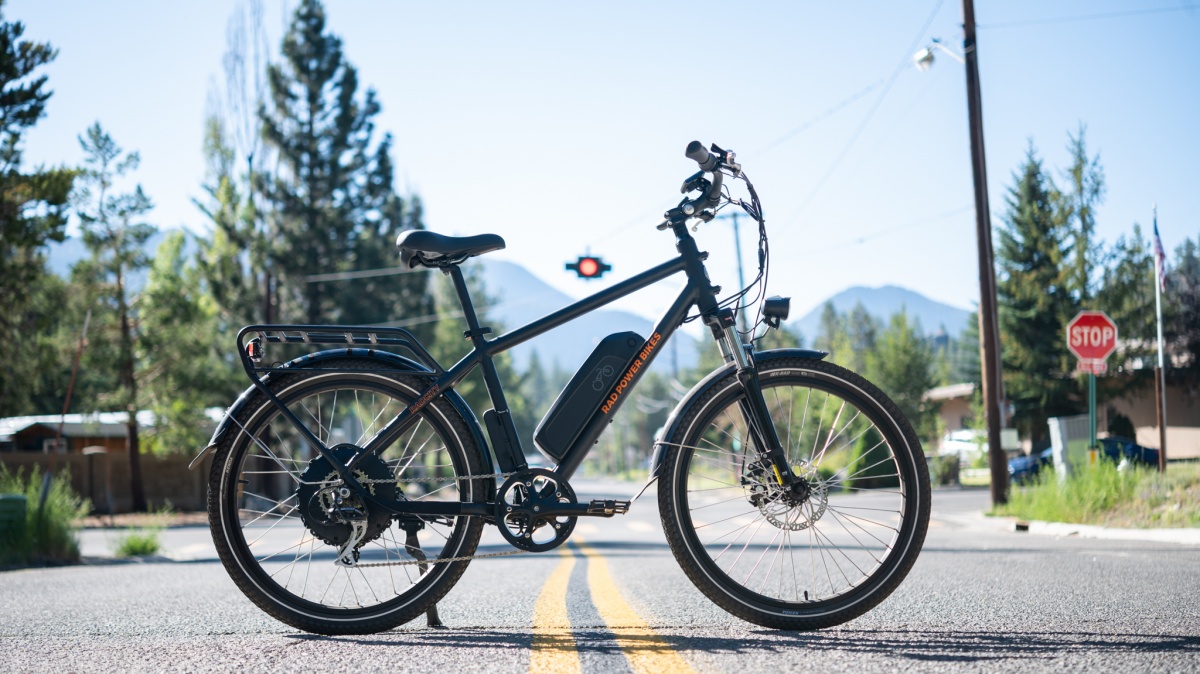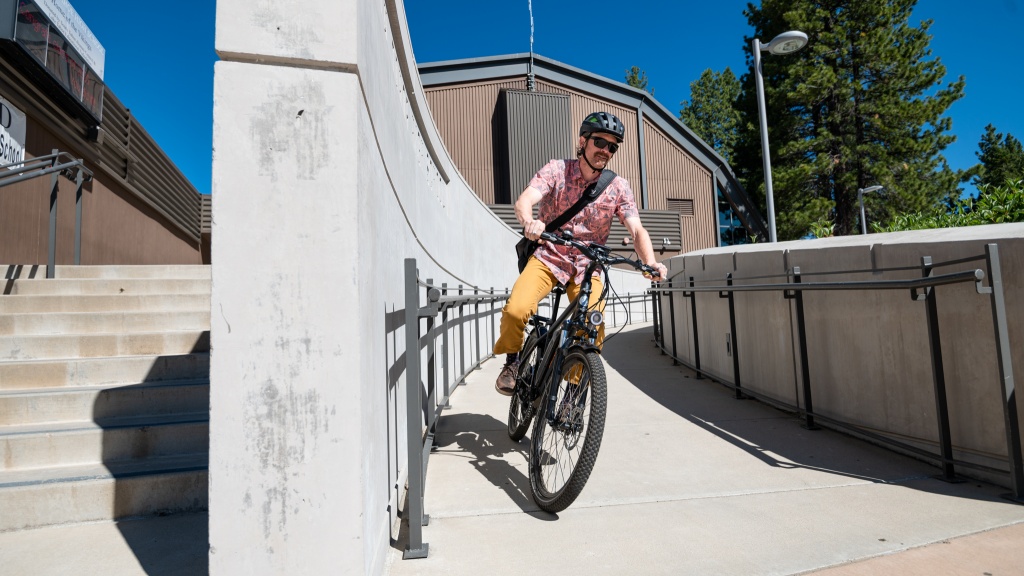Rad Power RadCity 4 Review
Our Verdict
Our Analysis and Test Results
Rad Power introduced the RadCity 5 Plus electric commuter bike in September of 2021.
Rad Power Bikes is a relatively young company that has taken the electric bike market by storm. They now produce a full line of reasonably priced e-bikes with ten different models to choose from. We put the versatile RadCity 4 up against a selection of similarly priced competitors to see how it would compare.
Ride
The RadCity 4 impressed us with its comfortable and smooth ride quality. This bike has predictable handling and a nicely dampened feel thanks to its front suspension and girthy tires. It also has a relaxed geometry, ample adjustment range in the seatpost and stem, plus a comfy saddle and ergonomic grips. Additionally, it comes with user-friendly features like fenders, front and rear lights, and a sturdy cargo rack as standard equipment.
Comfortable is one of the best ways to describe the way the RadCity 4 handles. While it may not be the sharpest or zippiest handling bike, it makes up for it with its impressively smooth and calm feel in all situations. In our cornering tests, we found it performed well at both high and low speeds, and long and short radius turns with a predictable and easy-going demeanor. Likewise, during our high-speed downhill test, we found the RadCity to be impressively stable and steady at speeds well over the 20 mph mark. The Suntour fork provides 100mm of smooth front suspension that helps to take the edge off bumps, cracks, and potholes in the road. Meanwhile, the 2.3-inch wide tires have a larger air volume that helps dampen and smooth the ride over rough surfaces and aids in traction with a larger contact patch. The versatile tread design of the K-Shield puncture-resistant tires is fast-rolling on pavement, with just enough tread to grip well on variable surfaces.
The comfort of the RadCity 4 doesn't just apply to the way it handles. This bike is also quite comfortable. The geometry is relaxed, and it allows for a relatively upright and casual body position. The stem is adjustable and allows the user to shift the handlebar up or down for their ideal handlebar position. The seatpost also offers several inches of height adjustment, which should accommodate riders with inseam lengths from 27-34 inches, according to the Rad Power sizing guide. Our 6-foot tester with a 32-inch inseam had no trouble fitting on this bike and achieving proper leg extension. They also make a Step-Thru version of the Rad City, which may work better for riders with shorter inseams or those who prefer not to swing their leg over the higher top tube of the non-step-thru version. During our range test, we rode the RadCity for nearly 2 hours without stopping, and we found the ergonomic grips to be quite comfortable on the hands. The seat also proved to be friendly with ample cushioning, a pressure relief channel, and a large but not huge platform.
We found the components on the Rad City 4 to perform their duties well while testing. The 7-speed Shimano Altus drivetrain shifted flawlessly from the minute we took the bike out of the box. The Tektro Aries mechanical disc brakes with 180mm rotors did an excellent job of handling the speeds and weight of this bike when slowing and stopping. Standard features like front and rear fenders, head and taillights that operate off the bike's power supply, and an integrated rear rack that can handle up to 45 lbs just add to its well-rounded performance. Errands, commuting, riding for fun, you name it, and this bike is ready for whatever you are. All of that said, the RadCity 4 is heavy, weighing in at 63.3 lbs, and it is a bit of a bear to pedal around without pedal assistance should the battery run out.
Range
Boasting a sizeable 672Wh battery storage capacity, we found the RadCity 4 to have an impressive distance range. Rad Power claims a low-end range of 25 miles, and we feel that is relatively accurate given the results of our throttle-only distance range testing.
During our range test, we rode the RadCity 4 a total of 26 miles with 1,400 vertical feet of elevation gain. This test took 1 hour and 45 minutes with an average speed of 15 mph. This test was performed using the throttle only with no rider input except when starting from a complete stop. We feel this is the absolute low-end of this bike's capability, and it should be easy to double its range using pedal assistance while pedaling.
Power
With a 750W rear hub motor, the RadCity 4 is no slouch when it comes to power delivery. It may not be the zippiest or quickest to accelerate, but once it gets going, the motor feels strong, and it easily scoots along at 20 mph using the throttle or pedal assistance. The five pedal assist modes provide a huge range of support for your pedaling efforts with smooth and consistent power delivery.
This Class 2 electric bike comes equipped with a throttle to propel you in full-electric mode without the need to pedal. Acceleration when using the throttle is good, not the quickest we tested, but it never felt sluggish either. The RadCity 4 has no problem getting up to its top speed of 20 mph on flat ground, and we found that it was one of the strongest when going up moderately pitched hills. Some bikes have a tendency to bog down when using the throttle uphill, but this bike felt strong and continued to accelerate where others faltered.
The RadCity 4 has five pedal assist modes numbered 1 (lowest) to 5 (highest). These modes also have “operation mode” names for levels 2, 3, 4, and 5, called Eco, STD, Power, and Speed, respectively. We found the five levels to offer a huge range of pedal-assist support from very light in level 1 to very strong in level 5. In all of the different levels, the power comes on gradually with about a half rotation of the cranks and ramps up. The delivery of the power isn't jumpy; instead, it feels smooth and consistent. Once up to speed, the motor continues to deliver the same amount of support regardless of rider effort, and this bike doesn't seem to have an advanced torque sensor like some other models. It is straightforward to get the RadCity up to its top pedal-assisted speed of 20 mph before the power cuts off. It is possible to get this bike above 20 mph under your own power, although it isn't easy to keep it there given its heavy weight.
Interface
The RadCity 4 has an excellent user interface that includes ergonomic, intuitive controls, and a large LCD display screen. In fact, this is among the best systems used on all of the bikes in our test selection. Battery charging is relatively standard, and the battery can be locked to the bike and removed for charging or security.
The controls of the RadCity 4 consist of a small handlebar-mounted unit located by the left grip. There are a total of three buttons arranged in an ergonomically friendly layout that control all of the functions of the system. There is a Mode button in the center that turns the power on and off and changes the information on some of the display fields. The + button shifts up, and the - button shifts down through the pedal assist modes. Simultaneously pressing both the mode and + button turns the lights and the screen's backlight on or off, and pressing and holding the - button engages the walk mode. The twist throttle is stealthily integrated into the right grip and controls the throttle power of the bike. The taillight also has a small button that allows the user to make it blink when the lights are turned on.
The LCD display is centered on the handlebar over the stem in an easy to see location. The screen measures 2.25 x 1.5 inches with 6 data fields displayed. The upper left of the screen is the battery life indicator, which is the shape of a battery with 5 bars representing the remaining battery charge. The upper right field is distance, which can be displayed as trip odometer or overall odometer by pressing the mode button. In the center, it shows your current speed in large numbers in mph or km/h. Below the speed field is the operation mode, which tells you what pedal assist setting you're using in a non-numerical format. The bottom left is the pedal-assist display that shows your pedal assist setting as a number (0-5). The bottom right corner of the screen is the watt meter/error code indicator that shows the watts the motor is putting out when in use, or an error code if something goes wrong. At the bottom of the screen, there is also a USB port that can be used to charge devices.
The battery is attached to the downtube of the frame, and it can be locked in the on or off position or removed from the frame. The battery must be in the locked and on position for power to be turned on. The charging port is relatively standard and has a small rubber cover to keep out dust, debris, and moisture.
Assembly
Rad Power is a consumer-direct electric bike brand. That means they skip the middle man, and their bikes get shipped directly to your door, and there is some assembly required. The RadCity 4 arrived with about 80% of the assembly completed, and while it wasn't particularly difficult to finish, it was a little more time-consuming than most.
The first thing we noticed about the RadCity 4 when it arrived was its packaging. Rad Power is a hip company, and that is reflected in their bike boxes that have fun graphics printed on both sides. The large mural-style scenes can be used as coloring boards for the kids, and there was even info on the inside flap that advertised a coloring contest. Beyond the fresh style of the box, it also has reinforced holes to make picking the box up easier on your hands and reduce the likelihood of damaging the box. The packaged bike is quite heavy, the bike weighs just over 63 lbs, and it is close to 70 lbs with all of the packaging. Moving it around is easiest with two people, as is removing the heavy bike from the large box. We were able to get the bike out of the box with one person, but an extra set of hands would have been appreciated.
Once out of the box, it is immediately apparent that the RadCity 4 is very well packaged and protected from shipping damage. Every part of the bike is meticulously wrapped in protective foam, and all of the moving or loose parts are secured with zip ties. Removing all of the protective materials took about 10 minutes alone. Once unwrapped, we located the printed owner's manual, which has detailed step by step instructions for the remainder of the assembly process. Rad Power also sent us an e-mail with a number of helpful links and resources, including a new owner's guide and assembly manuals. A small zippered tool kit is also included, and it has everything you need to complete the remaining steps. Like most bikes, assembling the RadCity 4 involves standard things like attaching the front wheel, handlebar, seat, and seatpost. Additionally, attaching the front fender and headlight are a couple more simple steps that add about 5 minutes to the process. Unlike some bikes we tested, the brakes on the RadCity 4 did require some adjustment before riding as the cable tension was far too tight from the factory. When all was said and done, it took almost exactly 1-hour to get the RadCity ready to roll.
Should You Buy the Rad Power RadCity 4?
With a killer combination of well-rounded performance and a reasonable price, the RadCity 4 is a solid value. With its respectable distance range, powerful motor, comfortable ride, and great user interface, it's hard to go wrong. We feel this versatile model is well suited to just about anything from commuting to casual trips to the beach.
What Other E-Bikes Should You Consider?
This user-friendly e-bike comes equipped with a lot of user-friendly features like lights, fenders, and a cargo rack. If you want a dedicated cargo e-bike, check out the Rad Power RadWagon 5. If you're short on cash but still looking for a great e-bike, the Ride1Up Turris XR is a good bet. And for our top-rated Class 2 model, the updated Rad Power RadCity 5 Plus is sure to please.












